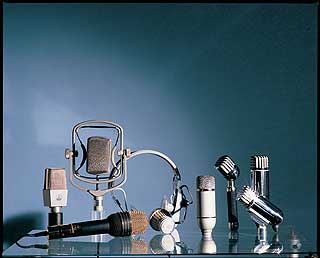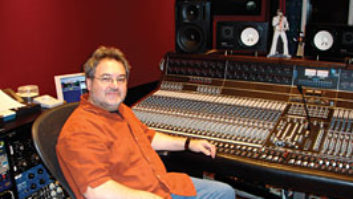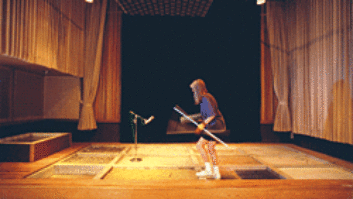
Some AKG microphones from the ’40s, ’50s and ’60s, from left: C-12A, D-25, D-112 (old version), K-59 headset, D-58, DY-9, DYN-20 and DYN-200K
In pro audio’s digital era, 50 years is both a half-century and an epoch. But it’s also a useful vantage point from which to take stock of a very changed industry and the unique position AKG—whose entire diverse product line is analog—occupies. First, though, a bit of history.
In May 1947, surrounded by the rubble that was Vienna in the wake of Allied bombing during World War II, physicist Dr. Rudolf Goerike and businessman Ernst Pless opened Photophon to begin manufacturing of cinema projectors and related equipment. The company was founded on Goerike’s particular expertise and on a solid marketing basis—movies were the great escape for many in the bleak landscape of postwar Europe. Goerike and Pless soon changed the company name, for business reasons, to AKG, which stands for Akustische u. Kino-Gerate (Acoustic and Film Equipment). But the acoustic part soon became the center of the fledgling company’s focus, based on Goerike’s innovative microphone diaphragm designs. The first success—and the world’s first single-element cardioid microphone—the AKG D-12, propelled the company’s fortunes even as Pless was delivering orders on a bicycle, and at times accepting payment in the form of black market cigarettes and butter. The mic also introduced the AKG logo of three overlapping cardioid patterns. The film equipment business was discontinued in 1965.
AKG’s product line has been diverse in the past half-century, sometimes oddly so. While its professional microphone line was building, AKG was also making car horns, door intercoms, telephone handsets (telecommunications products continue to be a large seller for the company) and in-pillow speakers—a brief fad from the 1950s—all of which are represented in a compact museum display in the lobby of the company’s sprawling 4.2-acre plant in Vienna’s southern reaches, where 450 people make a heck of a lot of microphones.
But it was the D-12 that formed the basis of AKG’s success in pro audio. Developed in 1953, the dynamic mic offered a tight pattern and extended low-frequency response to an industry on the verge of hi-fi. It quickly gained an avid following, which opened the door to subsequent new products, such as the C-12 condenser mic (developed in 1953), also destined to become a classic. Both microphones were produced in several versions, including the C-12A and stereo C-24, the AKG Tube and the C-12VR, the most recent model with the original capsule. Yet another classic of the era is the C-414, which is based on the original capsule design for the C-12 but with smoother upper-frequency characteristics, which made it a favorite for vocal applications.
The development of AKG’s product line over the years reflects the massive philosophical shift the overall pro audio industry has undergone: from that of an engineering-driven business to one predicated on marketing. The C-12, developed by recently retired AKG engineer Konrad Wolf, was innovative both because of its diaphragm design and its slender tubular housing, which was considerably smaller than Neumann’s competing U Series and which also had shock-mounting integral to the design, as opposed to an elastic-web mic suspension. But for all of its early success in broadcast, film and music applications, the C-12 (also marketed by Siemens as the SM 204 and by Telefunken as the M251, part of an OEM strategy to enhance AKG’s limited postwar distribution capability) was discontinued around 1963 as solid-state electronics took off and the electronics industries—pro and consumer—looked to FET technology to free them from cumbersome tubes.
“Everyone wanted smaller, FET-type microphones,” recalls Norbert Sobol, AKG’s affable pro audio products manager. “We had success making smaller tube microphones, like the C-12, replacing the large 6072A tubes with smaller Nuvistor tubes. The same with the C-414, which was using solid-state circuitry but used the same capsule in a smaller housing and which was the first interchangeable microphone assembly. But solid-state was a big buzzword at the time, so everyone was switching to that, including us.”
The C-414 was originally intended as the first AKG high-end FET offering (the C-414 comb) in 1971, using the same modified rectangular shape first designed for the C-12A in 1962. By the mid-1970s, though, the C-414 was using tube circuitry with its smoother C-12-based diaphragm. It went through various sub-types: the C-414EB/P48 reflected the fact that by 1977 U.S. consoles had standardized 48-volt phantom power (the “E” phonetically represented “XLR,” as opposed to the “CB” version for the German DIN plug standard, and the C-24 stereo version, so designated because it utilized two C-12 capsules).
Early FET designs and pop music never quite meshed, and rock ’n’ rollers brought demand for tube sound back with a vengeance in the mid-1970s. “At first, we thought going back to tubes would be a fad,” Sobol remembers. “But within a few years, we realized—quite happily—that it was not. I think every engineer has a special place in his heart for the way tubes sound. In 1983, we came out with the first reissue of the C-12 design [same electronics but with a 414 capsule and a smaller housing], The Tube.” It was followed 11 years later by the C-12VR, which was virtually the same as the original C-12 design, replacing the C-414’s capsule with the edgier characteristics of the original C-12 capsule. That same capsule was also re-created in the 1993 transformerless TL-2 version of the C-414.
Acknowledging that the pro audio market has evolved based on a digital revolution—one that microphone companies could not have been part of—Walter Ruhrig, AKG’s music division product manager, says, “This new market was not developed by companies like AKG. The new market has very specific requirements as far as accessories are concerned.” In response, he says, AKG has developed entirely new lines, including the C-3000—a less expensive large-diaphragm microphone that includes high-end features such as shock-mounting, yet at a cross-market price—and the Emotion and Performers Series, which aim at entry-level studio and live sound niches. In addition, the C-414 has seen its own retail price reduced twice in two years.
“The major change that has been seen is that marketing now leads engineering, the reverse from the way it used to be,” Ruhrig says. “We saw it was time to enter what has become the mass market of pro audio, which we did with the Emotion Series, available at very low cost. The Performer Series is positioned in the gray zone between consumer and musicians. Even the packaging has become more consumer-oriented.”
As if to underscore that point, an interview with AKG wireless products manager Roland Scholz focuses as much on the packaging for the WMS-51 VHF budget-priced wireless unit as on the product itself. The package includes:
• A brightly colored box with application icons on the cover—along with an endorsement photo of Simply Red lead singer Mick Hucknall—and graphically illustrated product information on the back; Scholz believes this can take the place of the sales personnel, who are increasingly less available on a one-to-one level as pro audio moves into the Wal-Mart age.
• A color-coded frequency chart, which, Scholz points out, makes things easier for both salespeople and consumers.
• And a cross-marketing for AKG’s Micro-Mic line of instrument microphones. (Doug McCallum, AKG’s sales and marketing VP in the U.S., commented that, while the pro audio market is becoming more global, the U.S. and European markets still have differences, and that AKG’s U.S. operation is focusing on the WMS-300 UHF wireless system aimed at a mid-market price point.)
But while the industry is moving toward a mass market, no one at AKG believes that should have a deleterious effect on quality. AKG benefits from a unique manufacturing capability that evolved over the years, centered on production lines that dovetail automation developments from other industries such as plastics—the incoming plastic for what will become transducers looks like bags of breakfast cereal—along with highly specialized manual assembly and the company’s ability to make many of its own tools.
Diaphragm manufacture is at the heart of the plant’s activity, framed by casing manufacture and electronics assembly. AKG has long used what they call “Tiefzieh Varimotion Technology” (Tiefzieh is an Austrian word that translates as “deep drawing”), essentially a transducer shaping methodology that both widens the frequency range of microphones by permitting more than one thickness in a single transducer and which also helps maintain consistency from one microphone to the next. “Manufacturing provides part of the character of a microphone’s sound,” explains Norbert Sobol. “And you keep the character consistent by keeping manufacturing with as little variation as possible. That’s difficult to do because every part of the microphone plays a part in its sound—the housing, the grille, everything. Once you’ve developed each part to where you want it, you have to freeze it in the manufacturing process and repeat it over and over every time without variation. That, we’ve learned how to do.”
That experience will be put to the test as AKG enters its second half-century. With its most recent reorganization behind it—ownership has changed several times since 1975, before the company became part of the largest single entity in pro audio, Harman International, in 1994—AKG will seek to remain at the top of the high-end microphone market, move deeper into the project/personal studio markets and the wireless and live sound markets, and introduce new products, such as the EMS-1 in-ear monitoring system, which was introduced at NAB and is scheduled to become available in late summer.
It has become routine in the pro audio business to ask whether a company can cover all the bases of the new mass-market paradigm. And the response tends to be an equally routine “of course,” laced with a whistling-in-the-dark bravado needed to tackle much broader horizons. But as AKG’s international sales manager Heinrich Zant puts it, “As long as we keep basing the future on what we’ve learned in the past, keep the quality at the same level that built the company in the first place, and keep our focus on the things we do well, like transducers, then we can do it.”



